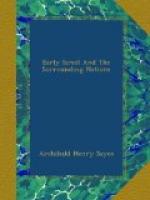As in the time of Meneptah, the Libyans took part with the northern tribes in the assault upon Egypt, and Sardinians and Sicilians followed behind them. But the main bulk of the invaders came from the Greek seas. The Danaans take the place of the Achaeans, and the Philistines are among their allies. The invaders had swept through western Asia, plundering and destroying as they marched, and bringing in their train contingents from the countries through which they passed. Hittites, Mitannians, and Amorites all followed with them, and the motley host of men and ships finally reached the Egyptian frontier. Here, however, they were met by the Pharaoh. The battle raged by sea and land, and ended in a triumph of the Egyptians. The invaders were utterly overthrown, their ships burned, their kings and leaders made captive. Egypt was once more saved from destruction, and Ramses III. was free to develop its resources and repair the damage that had been done.
First came a campaign in Canaan and Syria, the object of which was not to acquire territory, but to teach the Asiatic that there was once more an army in Egypt. The Egyptian forces seem to have gone as far as Hamath; at all events, they occupied southern Palestine, capturing Gaza, Hebron, and Jerusalem, and made their way across the Jordan into Moab. Another campaign carried the Egyptian troops into Edom, where they burned the “tents” of the Bedawin, and for the first and last time in history planted the Egyptian standard on the slopes of Mount Seir. Ramses now turned to the internal administration of his country, and the copper-mines of Sinai, like the gold-mines of the eastern desert, were worked with fresh vigour. The spoil won from the northern invaders made the Pharaoh the richest monarch of the age. Temples were built, and endowed with lavish generosity, and the priesthood must have grieved when he died at last after a reign of thirty-three years.
He was followed by a line of feeble princes. The high-priests of Amon at Thebes usurped their power, and finally dispossessed the last of them of the throne. A new dynasty arose in the Delta. In the south the government was practically in the hands of the Theban high-priests. With a divided kingdom the strength of Egypt passed away.
It was restored by a foreigner, Shishak I., the captain of the Libyan mercenaries. The Pharaoh whose daughter was married by Solomon must have been the last king of the old dynasty. Perhaps he sought to strengthen himself against his enemies in Egypt by an alliance with his powerful neighbour. At all events, the King of Israel allowed his army to march through Palestine as far as Gezer. The Egyptians flattered themselves that they had thereby asserted their old claim to sovereignty over Palestine, but the substantial gainer was the Israelitish monarch. He won the last independent Canaanite city without effort or expenditure, and was allowed to marry into the Solar race.




